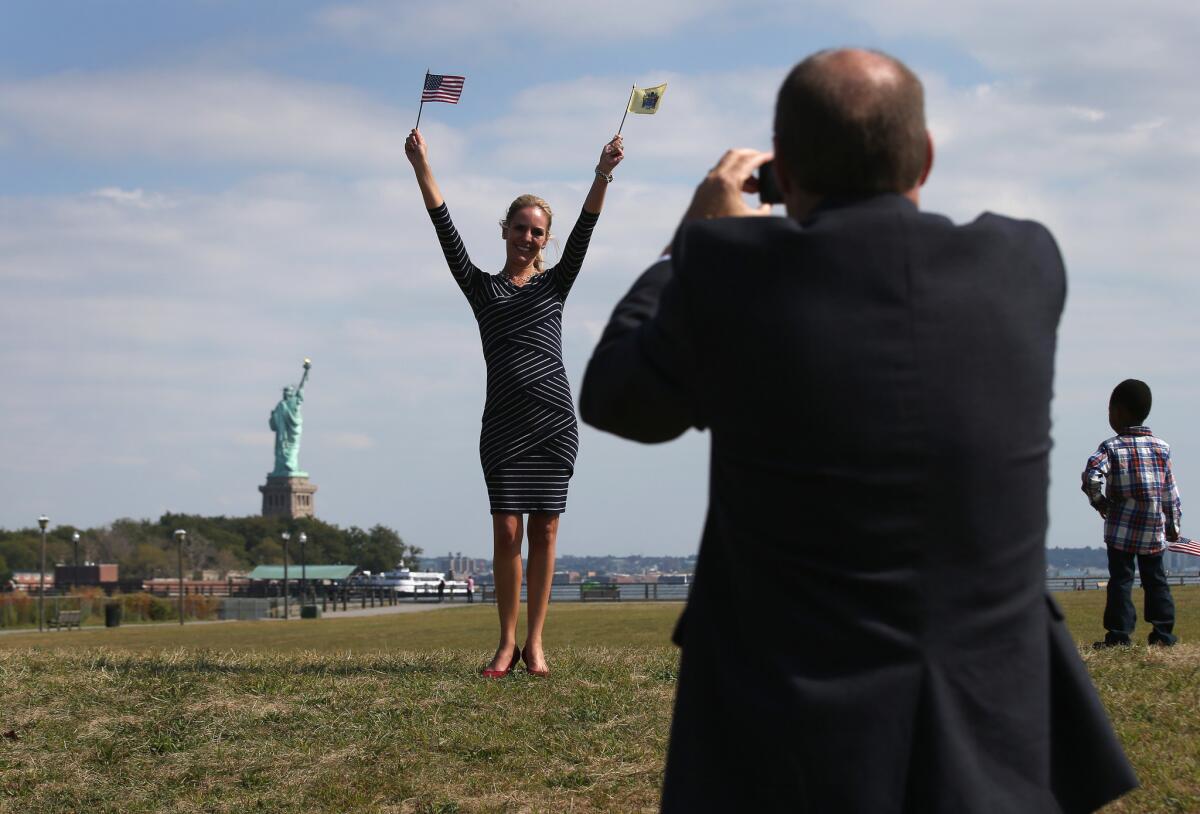Op-Ed: The evolving acceptance of dual citizenship

- Share via
Naturalization ceremonies are the stock in trade of American news organizations: the speeches, the number of countries represented among the applicants and the pictures of newly minted Americans waving miniature American flags.
One fact you won’t find in these stories: Most of those brand-new Americans will also be brand-new dual citizens. Most naturalization applicants keep their original citizenship as they acquire U.S. citizenship. Mexico, the Philippines, South Korea, Australia and a long list of other countries now openly accept the status. Other countries that officially reject the status, such as China, do nothing to police against it. Out of the top 20 source countries for naturalization applicants in 2013, 19 at least tolerate dual citizenship.
The number of dual citizens is soaring from other sources as well. Children born to immigrants in the United States will automatically have U.S. citizenship at the same time that they will typically inherit their parents’ nationality, or nationalities. Other native-born Americans are acquiring the nationality of their ancestors. Have a grandparent born in the old country? Getting Irish, Italian or Greek citizenship has never been easier and, with it, the right to live and work anywhere in the European Union.
Dual citizenship is now a common aspect of globalization, but it was once the bane of nations. The prevalence of bifurcated Americans would have been unimaginable to our political forebears. Theodore Roosevelt called the “theory” of dual nationality a “self-evident absurdity.” The 19th century American diplomat George Bancroft asserted that we should “as soon tolerate a man with two wives as a man with two countries.” To earlier generations, dual citizenship wasn’t just an anomaly, it was also a moral abomination.
Divided loyalty wasn’t the real source of the problem. There have been few cases of dual-citizen spies or saboteurs (they would be the last to advertise the alternate attachment). The language of morality and allegiance dressed up the human equivalent of turf battles between the United States and European sovereigns. In the 19th century, manpower equaled state power. Most European countries refused to recognize naturalization in the United States. Naturalized Americans on family visits back home would often find themselves conscripted into homeland armies. U.S. authorities would intervene on their behalf, and diplomatic dust-ups were the result.
Today, dual citizens pose no such threat to cordial bilateral relationships. With respect to military service and income taxes, states have essentially agreed to make residence, not citizenship, the key criterion. They have even come to terms on democratic representation. Many states allow their shared citizens to participate in national elections even though they aren’t residents. Italian Americans with shared citizenship, who are perfectly free to vote in the U.S., can also vote for a North American representative to the Italian Parliament.
Immigrant-sending countries see emigrant populations as an economic resource. Citizenship becomes a tool for cementing trans-boundary diaspora ties. Mexico was once deeply suspicious of those who moved permanently to the United States and terminated the Mexican citizenship of anyone who became naturalized as an American. That rule was abolished in 1998. By default, all Mexicans acquiring U.S. citizenship after 1998 also remain citizens of Mexico. India is the only major source country that still rejects dual citizenship (its constitution expressly prohibits the status).
Sure, it may mean that some dual citizens will be rooting for the other team — sometimes literally, as happened in a 2011 Rose Bowl contest between the U.S. and Mexican national soccer teams. But sports is probably the only context in which states are still pitted in zero-sum contests. Some may continue to frame the issue as one of divided loyalty. In practice, in situation after situation, dual citizenship hasn’t proved a problem.
It’s true that new U.S. citizens are still required to “renounce and abjure all allegiance and fidelity to any foreign prince, potentate, state or sovereignty, of whom or which [they] have heretofore been a subject or citizen.” The oath has never been enforced by U.S. authorities. Historically, that was taken care of by other countries who revoked the citizenship of those becoming naturalized here.
Recent efforts to enforce the renunciation oath have gone nowhere because the advantages of dual citizenship cut across a variety of politically powerful constituencies. Our new citizens deserve a revised oath reflecting contemporary realities. In the meantime, the archaic phraseology won’t stop many from holding on to their original nationality.
And shouldn’t they? Citizenship is an important part of individual identity. There’s no reason it needs to be exclusive. Those of us who are U.S. citizens also have other associations: religions, civic institutions, advocacy groups. That some of us belong to other nations doesn’t undermine our capacity to be good Americans.
Peter J. Spiro, a law professor at Temple University, is the author of “Beyond Citizenship: American Identity After Globalization.”
This is part of an ongoing conversation exploring the meaning of citizenship in America today. For more, join us at latimes.com/citizenship and #21stCenturyCitizen. We’d love to hear from you. Share your thoughts, rebuttals and experiences with us at letters@latimes.com.
Follow the Opinion section on Twitter @latimesopinion
More to Read
A cure for the common opinion
Get thought-provoking perspectives with our weekly newsletter.
You may occasionally receive promotional content from the Los Angeles Times.










